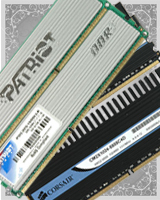Your 64-Bit Check List: Potential Issues You Might See
Operating System Details And Issues
Windows retail versions are typically available in both 32-bit and 64-bit varieties. There are special edition discs that contain both versions, such as a Vista DVD for Microsoft MSDN subscribers. But you have to pay attention to ensure that you install the right version of Windows, as there is no way to change the version once it has been installed.
How Much RAM Do You Want?
Going for a 64-bit system and large amounts of memory not only provides more breathing room for applications, it also allows modern operating systems such as Windows Vista to perform well. First, this means relocating less data into the slower swap file on your hard drive. Second, Vista will take advantage of more RAM by intensively using its SuperFetch feature, which pre-loads applications in the order of importance, meaning that your most popular applications will be pre-buffered into available main memory first. The purpose is to have these applications available almost instantly when you decide to launch them. Since memory kits providing four or even eight gigabytes of RAM have become really affordable, this would be our choice. Power users and enthusiasts definitely want 8 GB of RAM on a 64-bit system today; normal users should not utilize anything below 2 GB. 1 GB is only sufficient for occasional PC use and simple applications.
32-Bit Issues On Windows
As mentioned in the introduction, 32-bit versions of Windows will not give you the full 4 GB of RAM that you might have installed, as Windows components and devices requiring so-called memory mapped access have to reside within the first 32 bits (4 GB) of main memory. A graphics card with 512 MB of on-board graphics RAM requires this memory to be mapped into the system memory, effectively reducing your total capacity by 512 MB. Windows Vista typically limits the available memory to 3.12 GB, but depending on your system hardware, the effective RAM capacity may even be smaller. Add-ons such as Microsoft’s .NET framework can consume 200 MB or more. Linux does things differently, as the kernel never requires more than 1 GB; hence up to 3 GB of RAM can be assigned to processes.
Physical Address Extension instead of 64-bit Windows?
Some Windows versions support a feature that is known as Physical Address Extension (PAE), which means that more than 4 GB of memory can be addressed through a re-mapping process. Windows then not only utilizes the simple way of memory mapping described above, it uses a memory mapping that is based on three levels of paging instead of two. While this has been successfully deployed on servers, desktop systems tend to run into driver compatibility issues because of insufficient standardization: drivers might be assuming that PAE always requires more than 4 GB of RAM, or that addresses will always be 32 or 64 bits wide.
Get Tom's Hardware's best news and in-depth reviews, straight to your inbox.
Current page: Operating System Details And Issues
Prev Page The State Of The 64-Bit Union Next Page Driver Issues